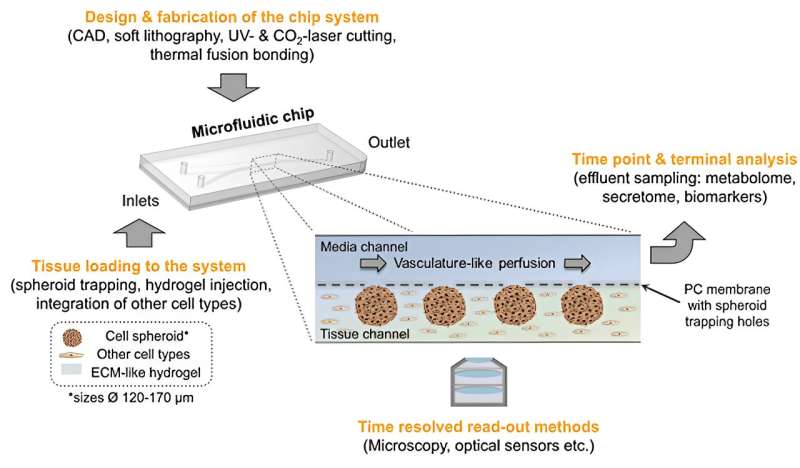This article has been reviewed according to Science X's editorial process and policies. Editors have highlighted the following attributes while ensuring the content's credibility:
fact-checked
proofread
Pancreas-on-chip platform with integrated sensors offers new avenue for diabetes research

More than 7 million people in Germany suffer from diabetes. Research into drugs to treat this widespread disease is still difficult. Scientists led by Prof. Dr. Peter Loskill from the NMI Natural and Medical Sciences Institute and the Faculty of Medicine of the Eberhard Karls University of Tübingen have now developed a technique that significantly improves the view at the molecular and cell biological level in the pancreas.
To do this, they recreated organ-like structures on an organ-on-chip platform. Results from drug tests on these structures can be transferred to human organisms better than traditional methods. They have now published these results in the journal Lab on a Chip.
The disease diabetes mellitus is caused by a metabolic disorder in the pancreas. The pancreas normally regulates blood sugar levels in the body by releasing the hormones insulin and glucagon.
Organ-on-chip technology involves growing tissue, i.e., cell clusters with specific functions, outside the body. These tissues, in this specific case made up of pancreatic cells, react to active substances in a similar way to the organ in the body. This allows reliable conclusions to be drawn about how drugs work.
"We have succeeded in reproducing a model of the insulin-producing units of the pancreas in microfluidic chips. We were also able to integrate tiny sensors into this chip that allow us to make statements about the condition of the organ model in real time without affecting the cells," explains Peter Loskill, Professor of Organ-on-Chip Systems.
"Microfluidic" means that nutrients are transported to the cells via very fine channels, just like through blood vessels, and metabolic products are removed. "By recreating the cells' natural microenvironment in the body, we can carry out significantly longer and more meaningful experiments," says Loskill. The development therefore offers the opportunity to make great progress, and not just in diabetes research.
How does organ-on-chip work?
For organ-on-chip models, organ-specific cells are grown outside the body in a customized microenvironment in a microfluidic chip. The cells can correspond to those of the pancreas, liver, heart muscle or brain, for example. The tissues built up from the cells are continuously supplied with nutrients on the chip in a similar way to the bloodstream. This allows them to be treated with medication, for example, or a disease state can be simulated through targeted manipulation.
Using a variety of analysis methods, it is possible to carry out time-resolved measurements of reactions to active substances or the progression of diseases.
Due to the possibility of working with human cells in particular, studies on organs-on-chips are potentially more transferable to humans than animal experiments, which could lead to a significant reduction in animal experiments in basic biomedical research and pharmaceutical research in the future.
More information: Katharina Schlünder et al, Microphysiological pancreas-on-chip platform with integrated sensors to model endocrine function and metabolism, Lab on a Chip (2024). DOI: 10.1039/D3LC00838J



















